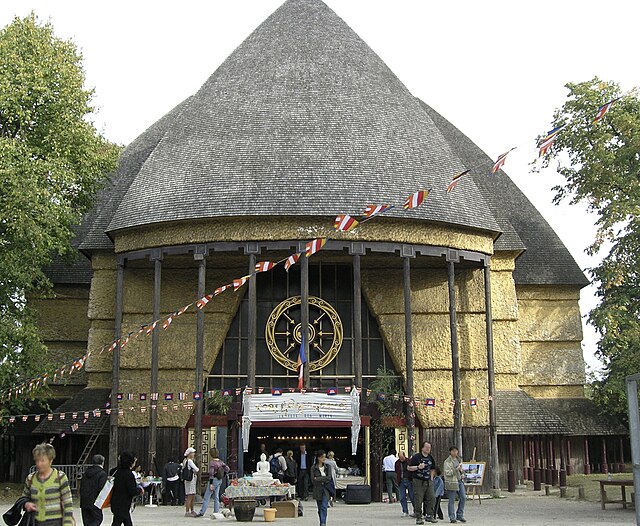Although there was regular contact between practising Buddhists and Europeans in antiquity the former had little direct impact. In the latter half of the 19th century, Buddhism came to the attention of Western intellectuals and during the course of the following century the number of adherents has grown. There are now between 1 and 4 million Buddhists in Europe, the majority in Italy, Germany, Hungary, France and the United Kingdom.
The Pagoda in the Bois de Vincennes, Paris
Das Buddhistische Haus
The main stupa at Samyé Ling
The 30-meter-high stupa in Zalaszántó, Hungary
Buddhism in the West broadly encompasses the knowledge and practice of Buddhism outside of Asia in the Western world. Occasional intersections between Western civilization and the Buddhist world have been occurring for thousands of years. The first Westerners to become Buddhists were Greeks who settled in Bactria and India during the Hellenistic period. They became influential figures during the reigns of the Indo-Greek kings, whose patronage of Buddhism led to the emergence of Greco-Buddhism and Greco-Buddhist art. There was little contact between the Western and Buddhist cultures during most of the Middle Ages but the early modern rise of global trade and mercantilism, improved navigation technology and the European colonization of Asian Buddhist countries led to increased knowledge of Buddhism among Westerners. This increased contact led to various responses from Buddhists and Westerners throughout the modern era. These include religious proselytism, religious polemics and debates, Buddhist modernism, Western convert Buddhists and the rise of Buddhist studies in Western academia. During the 20th century, there was a growth in Western Buddhism due to various factors such as immigration, globalization, the decline of Christianity and increased interest among Westerners. The various schools of Buddhism are now established in all major Western countries making up a small minority in the United States, Europe, Australia and New Zealand.

A coin of Menander I (r.160–135 BC) with a dharmacakra and a palm.
Heracles depiction of Vajrapani as the protector of the Buddha, 2nd century Gandhara, British Museum.
Extent of Buddhism and trade routes in the 1st century AD.
Ven. Hikkaduwe Sri Sumangala Thera and Henry Steel Olcott, the first President of the Theosophical Society, in Colombo, 1889.








